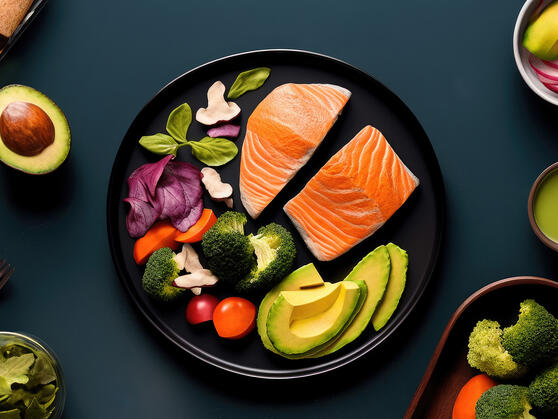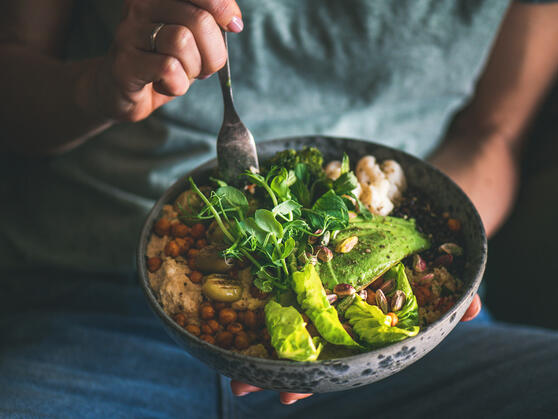
Nutrition &
Trends
Dietary fiber offers health benefits that are appealing to consumers.
More and more members of society are aware of the importance of a healthy lifestyle. The understanding of what a healthy diet is and the objectives of consumers are diverse. Thus, the resulting nutritional and food trends are as well. There are various physiological benefits of dietary fibers, which makes it the ideal nutrient with regard to nutritional needs.
Dietary fiber has been shown to improve blood sugar metabolism, promote digestion and gut health, and help to prevent colon cancer, to name just a few of the benefits. However, the basic requirement is that food containing health-promoting nutrients, is better accepted by consumers.
Dietary fiber proves to be the ideal solution, since it is naturally present in plant-based foods, but can also be enriched in a huge variety of processed food categories. The aim is to provide consumers with the appropriate range of food products to enable them to follow a healthy diet with sufficient dietary fiber content, regardless of their taste preferences.
Nutrition Facts
Blood Glucose Metabolism & Diabetes

Insoluble Dietary Fiber Improves Insulin Sensitivity
Cutting out sugar is a strategy for preventing or managing diabetes that many consumers follow. Even more effective and longer lasting is sufficient dietary fiber consumption.
Dietary fiber impedes nutrient absorption in the human small intestine, thereby slowing the rise in blood glucose. Observational studies also show that it affects glucose tolerance and insulin sensitivity, which has a huge impact on downstream metabolic processes.
The latter consistently applies for insoluble dietary fiber e.g., from cereals and whole grains, but not for soluble dietary fiber.
Digestive Health

Healthy Digestion Is the Basis for Intestinal Health and Downstream Metabolic Processes
Intestinal health has been a taboo subject for years. The increasing number of people suffering from digestive problems and the recognition of how important intestinal health is for overall wellbeing finally turned it into an important health trend.
Understanding the abdomen as a “second brain” that is connected via the intestinal microbiota to different organs and metabolic processes increases consumer motivation to support it by having a healthy diet. Along with this, the interest in dietary fiber is increasing. Dietary fiber provides a healthy digestion by affecting fecal bulk and transit time and serves the intestinal microbiota as an energy substrate.
In order to ensure dietary fiber availability along the entire intestine, the consumption of a mixture of rapidly and slowly fermentable dietary fibers is recommended. The proportion of insoluble dietary fiber also improves tolerability so that side effects like flatulence can be prevented.
Weight Management

Dietary Fiber Affects Weight Regulation in a Number of Ways and Helps to Prevent Obesityrelated Complications
With such an extensive range of foods, delicious and available everywhere, keeping one’s diet balanced is not easy. Even though awareness of the relevance of healthy eating is increasing, taste preferences have been shaped over decades and cannot easily be changed.
Low calorie alternatives based on dietary fiber can therefore help consumers with limiting the intake of energy dense food and drink products high in fat and sugar. Dietary fiber is not only the nutrient with the lowest energy density, but also highly satiating. Paired, these two aspects provide excellent support for weight control. In its role as a prebiotic, fiber alters the intestinal microbiota, which has been shown to impact weight regulation. Focusing on intestinal health and low-calorie food alternatives is therefore promising in the fight against obesity.
In addition, overweight people are at high risk of metabolic complications, which is why adequate fiber intake is particularly important in this population group for health prevention.
Cardiovascular Diseases

The Risk of Cardiovascular Diseases Can Be Reduced by Eating Foods Rich in Fiber and Unsaturated Fatty Acids
Cardiovascular diseases (CVDs) are the most common consequence of diet-related risks around the world. Obesity in particular contributes to the fact that it is no longer just people above 60 who are affected, making it a key public health concern.
However, the development and manifestation of metabolic diseases, especially if they occur as a result of being overweight, can be counteracted preventively by sufficient physical activity and more balanced, high fiber diets. High salt intake is linked with an increase in blood pressure. A high intake of saturated and trans fats is linked with unfavorable blood lipid levels. Both increase the risk of CVDs.
Fiber and unsaturated fatty acids, on the other hand, have been shown to be beneficial for heart health. In addition to directly affecting parameters of heart health, dietary fiber represents an ingredient for the development of food products with heart-friendly nutritional profiles.
Cancer

Dietary Fiber Contributes to a Strong Intestinal Barrier That Protects against Toxins and Tumorp Erromoting Metabolites
Colon cancer is one of the most common types of cancer, although preventive measures are very likely to prevent almost half of all cases. An important component of anti-carcinogenic mechanisms is a healthy and regular digestion.
This is characterized by a short transit time and a high stool weight that not simply determines the frequency of emptying your bowels. Fiber is known to be beneficial for digestion. At the same time, it helps maintain a healthy intestinal microbiota and an intact gut barrier. Both protect against the formation of tumor-promoting metabolites.
The most important thing for the intestines is sufficient fiber as an energy source to keep itself and the intestinal microbiota healthy and functional.
Immunity

A Balanced Intestinal Microbiota Is Key in the Immune System
The intestine is the most important place when it comes to training the immune system. It contains numerous immune cells and also represents an important barrier for protection against inflammatory diseases such as Crohn's disease.
Dietary fiber has an immunomodulating effect in the intestine, either directly, by strengthening the intestinal barrier through contact with the dietary fiber or indirectly by nourishing the intestinal microbiota. Maintaining a balanced gut microbiota requires the continuous availability of sufficiently complex carbohydrates as energy source. Gut microbiota dysbiosis might lead to inadequate energy supply for epithelial cells or even attack the inner mucus layer of the gut. The importance of a strong immune system is particularly evident in pandemic times.
However, low-grade inflammatory processes also play a role in chronic diseases such as diabetes, which could be prevented by an intact intestinal barrier.
Nutrition Facts

Insoluble Dietary Fiber Improves Insulin Sensitivity
Cutting out sugar is a strategy for preventing or managing diabetes that many consumers follow. Even more effective and longer lasting is sufficient dietary fiber consumption.
Dietary fiber impedes nutrient absorption in the human small intestine, thereby slowing the rise in blood glucose. Observational studies also show that it affects glucose tolerance and insulin sensitivity, which has a huge impact on downstream metabolic processes.
The latter consistently applies for insoluble dietary fiber e.g., from cereals and whole grains, but not for soluble dietary fiber.

Healthy Digestion Is the Basis for Intestinal Health and Downstream Metabolic Processes
Intestinal health has been a taboo subject for years. The increasing number of people suffering from digestive problems and the recognition of how important intestinal health is for overall wellbeing finally turned it into an important health trend.
Understanding the abdomen as a “second brain” that is connected via the intestinal microbiota to different organs and metabolic processes increases consumer motivation to support it by having a healthy diet. Along with this, the interest in dietary fiber is increasing. Dietary fiber provides a healthy digestion by affecting fecal bulk and transit time and serves the intestinal microbiota as an energy substrate.
In order to ensure dietary fiber availability along the entire intestine, the consumption of a mixture of rapidly and slowly fermentable dietary fibers is recommended. The proportion of insoluble dietary fiber also improves tolerability so that side effects like flatulence can be prevented.

Dietary Fiber Affects Weight Regulation in a Number of Ways and Helps to Prevent Obesityrelated Complications
With such an extensive range of foods, delicious and available everywhere, keeping one’s diet balanced is not easy. Even though awareness of the relevance of healthy eating is increasing, taste preferences have been shaped over decades and cannot easily be changed.
Low calorie alternatives based on dietary fiber can therefore help consumers with limiting the intake of energy dense food and drink products high in fat and sugar. Dietary fiber is not only the nutrient with the lowest energy density, but also highly satiating. Paired, these two aspects provide excellent support for weight control. In its role as a prebiotic, fiber alters the intestinal microbiota, which has been shown to impact weight regulation. Focusing on intestinal health and low-calorie food alternatives is therefore promising in the fight against obesity.
In addition, overweight people are at high risk of metabolic complications, which is why adequate fiber intake is particularly important in this population group for health prevention.

The Risk of Cardiovascular Diseases Can Be Reduced by Eating Foods Rich in Fiber and Unsaturated Fatty Acids
Cardiovascular diseases (CVDs) are the most common consequence of diet-related risks around the world. Obesity in particular contributes to the fact that it is no longer just people above 60 who are affected, making it a key public health concern.
However, the development and manifestation of metabolic diseases, especially if they occur as a result of being overweight, can be counteracted preventively by sufficient physical activity and more balanced, high fiber diets. High salt intake is linked with an increase in blood pressure. A high intake of saturated and trans fats is linked with unfavorable blood lipid levels. Both increase the risk of CVDs.
Fiber and unsaturated fatty acids, on the other hand, have been shown to be beneficial for heart health. In addition to directly affecting parameters of heart health, dietary fiber represents an ingredient for the development of food products with heart-friendly nutritional profiles.

Dietary Fiber Contributes to a Strong Intestinal Barrier That Protects against Toxins and Tumorp Erromoting Metabolites
Colon cancer is one of the most common types of cancer, although preventive measures are very likely to prevent almost half of all cases. An important component of anti-carcinogenic mechanisms is a healthy and regular digestion.
This is characterized by a short transit time and a high stool weight that not simply determines the frequency of emptying your bowels. Fiber is known to be beneficial for digestion. At the same time, it helps maintain a healthy intestinal microbiota and an intact gut barrier. Both protect against the formation of tumor-promoting metabolites.
The most important thing for the intestines is sufficient fiber as an energy source to keep itself and the intestinal microbiota healthy and functional.

A Balanced Intestinal Microbiota Is Key in the Immune System
The intestine is the most important place when it comes to training the immune system. It contains numerous immune cells and also represents an important barrier for protection against inflammatory diseases such as Crohn's disease.
Dietary fiber has an immunomodulating effect in the intestine, either directly, by strengthening the intestinal barrier through contact with the dietary fiber or indirectly by nourishing the intestinal microbiota. Maintaining a balanced gut microbiota requires the continuous availability of sufficiently complex carbohydrates as energy source. Gut microbiota dysbiosis might lead to inadequate energy supply for epithelial cells or even attack the inner mucus layer of the gut. The importance of a strong immune system is particularly evident in pandemic times.
However, low-grade inflammatory processes also play a role in chronic diseases such as diabetes, which could be prevented by an intact intestinal barrier.
Nutrition Trends
Gluten-Free Diet

Cereal Dietary Fiber Is Also Available in Gluten-Free Quality
Gluten causes health problems in people who suffer from gluten intolerance or celiac disease. This has given rise to the idea that avoiding foods containing gluten could lead to greater well-being in general, with or without diagnosis. The idea developed into a trend, so that 7-11% of people now eat a gluten-free diet, about half of them out of sheer conviction.
Wheat is the most prominent example of gluten-containing grain, but other grains also contain the undesirable protein. As reaction of the food manufacturers to the increased demand, a broad portfolio of gluten-free alternatives is now offered on the market. The range is growing steadily, especially in the baked goods sector. Between 2016 and 2021, 20% of baking ingredients and mixes and 14% of cereals launched on the market were claimed to be gluten-free. In order to be developed into a mainstream product, the nutritional and sensory quality of the products must be further improved by using the right ingredients.
From a nutritional point of view, dietary fiber is particularly suitable for this, since by avoiding gluten, valuable dietary dietary fiber sources are usually automatically omitted from peoples’ menu. If gluten-free diets lead to an increased lack of dietary fiber, they could do more harm than good with regard to mental and physical wellbeing.
Keto Friendly Diet

Dietary Fiber Is Still Needed, Otherwise the Intestinal Microbiota Will Starve
The ketogenic diet is a low carb diet in which fats are the main source of energy. It is partly used therapeutically, but it gained popularity through people who want to lose weight through this diet. In the US, around 5% of the population currently follow a ketogenic diet. The basic idea is that the carbohydrate restriction forces the body to increasingly switch to burning fat as an energy source. The trend is being fueled by the ongoing debate about sugar consumption and its adverse health effects.
The problem, however, is that consumers do not differentiate between simple carbohydrates, which include sugar, and complex carbohydrates, such as dietary fiber. If you reduce dietary fiber in your diet, you run the risk of starving your intestinal bacteria, which could have significant health consequences. Product launches show that the trend has arrived in Europe as well as the USA, Canada, India and Australia. More interestingly, the newly launched products reveal that food manufacturers appear to be addressing nutritional concerns by incorporating dietary fiber and healthy fats.
While the classic ketogenic diet was often associated with high meat consumption, new product developments focus on plant-based ingredients.
Vegan, Vegetarian and Flexitarian

A Big Advantage Is the Higher Dietary Fiber Intake
More and more people are living a vegan, vegetarian or at least predominantly vegetarian lifestyle while maintaining a certain degree of flexibility in terms of meat consumption. The so-called flexitarians are the fastest growing group and proportionally also the largest group. Also strongly represented groups today are the vegetarians with an average of 10% and the vegans with an average of 2%.
In order to achieve the goal of a healthy diet, a vegetarian and a vegan diet is highly recommended, at least regarding dietary fiber consumption. Vegans easily achieve the recommended intake of 25-30g per day with a daily intake of more than 40g, vegetarians are close with an intake of at least 28g per day and omnivores fall short entirely. Food manufacturers reacted to the trend and explored the possibilities of producing vegetarian and vegan product alternatives. Meat and milk substitutes are now mainstream products that appeal to a wide range of consumers in terms of sensory properties and taste.
With regard to nutrient composition, there is a possibility of adding dietary fiber to the products which are naturally rich in fat and protein, thereby satisfying those who buy them for health reasons and expect the products to support a more balanced diet.
Nutrition Trends

Cereal Dietary Fiber Is Also Available in Gluten-Free Quality
Gluten causes health problems in people who suffer from gluten intolerance or celiac disease. This has given rise to the idea that avoiding foods containing gluten could lead to greater well-being in general, with or without diagnosis. The idea developed into a trend, so that 7-11% of people now eat a gluten-free diet, about half of them out of sheer conviction.
Wheat is the most prominent example of gluten-containing grain, but other grains also contain the undesirable protein. As reaction of the food manufacturers to the increased demand, a broad portfolio of gluten-free alternatives is now offered on the market. The range is growing steadily, especially in the baked goods sector. Between 2016 and 2021, 20% of baking ingredients and mixes and 14% of cereals launched on the market were claimed to be gluten-free. In order to be developed into a mainstream product, the nutritional and sensory quality of the products must be further improved by using the right ingredients.
From a nutritional point of view, dietary fiber is particularly suitable for this, since by avoiding gluten, valuable dietary dietary fiber sources are usually automatically omitted from peoples’ menu. If gluten-free diets lead to an increased lack of dietary fiber, they could do more harm than good with regard to mental and physical wellbeing.

Dietary Fiber Is Still Needed, Otherwise the Intestinal Microbiota Will Starve
The ketogenic diet is a low carb diet in which fats are the main source of energy. It is partly used therapeutically, but it gained popularity through people who want to lose weight through this diet. In the US, around 5% of the population currently follow a ketogenic diet. The basic idea is that the carbohydrate restriction forces the body to increasingly switch to burning fat as an energy source. The trend is being fueled by the ongoing debate about sugar consumption and its adverse health effects.
The problem, however, is that consumers do not differentiate between simple carbohydrates, which include sugar, and complex carbohydrates, such as dietary fiber. If you reduce dietary fiber in your diet, you run the risk of starving your intestinal bacteria, which could have significant health consequences. Product launches show that the trend has arrived in Europe as well as the USA, Canada, India and Australia. More interestingly, the newly launched products reveal that food manufacturers appear to be addressing nutritional concerns by incorporating dietary fiber and healthy fats.
While the classic ketogenic diet was often associated with high meat consumption, new product developments focus on plant-based ingredients.

A Big Advantage Is the Higher Dietary Fiber Intake
More and more people are living a vegan, vegetarian or at least predominantly vegetarian lifestyle while maintaining a certain degree of flexibility in terms of meat consumption. The so-called flexitarians are the fastest growing group and proportionally also the largest group. Also strongly represented groups today are the vegetarians with an average of 10% and the vegans with an average of 2%.
In order to achieve the goal of a healthy diet, a vegetarian and a vegan diet is highly recommended, at least regarding dietary fiber consumption. Vegans easily achieve the recommended intake of 25-30g per day with a daily intake of more than 40g, vegetarians are close with an intake of at least 28g per day and omnivores fall short entirely. Food manufacturers reacted to the trend and explored the possibilities of producing vegetarian and vegan product alternatives. Meat and milk substitutes are now mainstream products that appeal to a wide range of consumers in terms of sensory properties and taste.
With regard to nutrient composition, there is a possibility of adding dietary fiber to the products which are naturally rich in fat and protein, thereby satisfying those who buy them for health reasons and expect the products to support a more balanced diet.

Long-Standing Application Experience
More than 140 years of experience and a team of scientists and experts.







